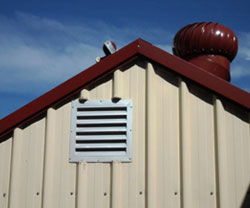Loft Ventilation Grilles
If you have a loft in your home, you need to make sure it’s properly ventilated. Although there are numerous problems that can result from an unventilated loft, they can all be avoided by adding vents to this space. Once you learn why ventilation is so important and how it works, you will be able to choose the right vents for your specific loft.
Why is Ventilation Important?
There are several serious problems that can occur if a loft is not ventilated. They include:
- Structural warping
- Mold growth
- Increased utility bills
Many homeowners are surprised to learn that an unventilated loft can lead to structural warping. The root issue is that the air in a loft gets much hotter than in other areas of your home. If a loft isn’t ventilated, this air won’t have anywhere to go. Instead, it will continue to get even hotter. Eventually, this can take its toll on your loft and home’s structural elements. Mold growth is another issue that can occur if hot air doesn’t have anywhere to go.
Once moisture begins accumulating in a loft, mold can begin growing in less than 72 hours. Not only can mold begin growing very quickly, but it can also spread in a short amount of time. While the worst issues can arise in a loft itself, the impact of a lack of ventilation isn’t limited to this area. Instead, a loft’s high temperature level can raise the temperature throughout your entire home. In order to combat this increased heat, your home will have to consume more energy.
How Does Ventilation Work?
Intake and exhaust vents are the two main components of ventilation. The purpose of intake vents is to pull fresh air into a loft. Once this air is pulled in, it creates a flow that leads to existing air being expelled. Exhaust vents give the expelled air a place to go. Instead of being trapped in a loft, this air is able to flow out and away. Although you may assume that power is a necessity for creating this type of flow, that’s actually not the case. Both vents can actually work together to create a consistent flow of air that is sustainable and doesn’t require any energy consumption.
What Type of Vents Can Be Used for a Loft?
Some of the most common vents used for a loft are plain slotted, louvre, circular and square. One of the benefits of plain slotted vents is they can be used to cover a very long area. With louvre vents, not only do you get an effective way to ventilate a loft space, but they’re also very attractive. And because they feature a covering over every slot, you won’t have to worry about rain blowing into your loft. While circular vents aren’t the right fit for every loft, they can work very well in certain settings. Thanks to their cube openings, square vents can allow a significant amount of air to flow through a loft space.

Categories
- Home
- Loft Ventilation Products
- Ceiling Loft Ventilation
- Gravity Loft Ventilation
- Lindab Ventilation
- Loft Eaves Ventilation
- Loft Rotary Vents
- Loft Ventilation Fans
- Loft Ventilation Grilles
- Loft Ventilation Pipes
- Loft Ventilation Systems
- Roof Ventilation Tiles
- Small Loft Vents
- Loft Ventilation Companies
- Loft Ventilation Information
- Types Of Loft Ventilation
